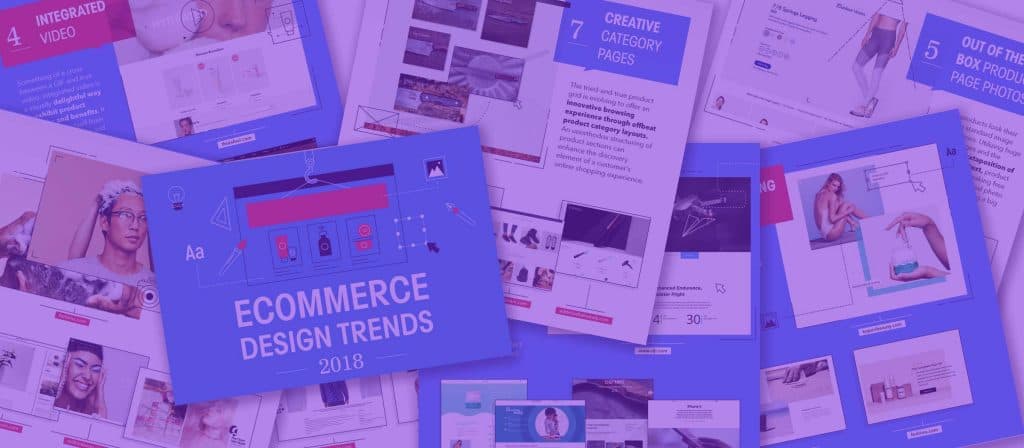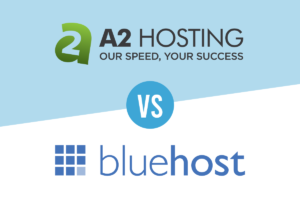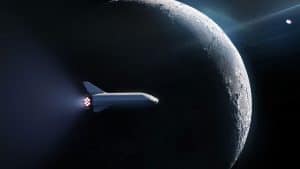With each passing year, ecommerce claims a larger percentage of retail revenue worldwide.
Even as the general public is increasingly coming to prefer shopping online sites still face many unique challenges to their success. How is an ecommerce site supposed to set itself apart from the rest and maximize its conversions?
The answer is excellent design.
Here are seven ecommerce design trends that are building brands and boosting conversions in.
(Click Infographic to Enlarge)

Breaking Down the Ecommerce Design Trends
Trends get a bit of a bad rap: we tend to think of them as shallow, passing fads. But in reality, trends can give us a telling glimpse into the conditions of the world around us. Indeed, the trends of last year often become the norms of this year. We saw this as 2017 trends towards mobile and narrowing the gap between social and ecommerce have established themselves as industry best practices.
Design trends rise to prevalence because they address ever-evolving consumer tastes and expectations. This is true across all disciplines of design, from graphic design to UX design to interior design. And as far as ecommerce goes, is there any better way to wow your customers than by anticipating their needs before they even realize them?
Between abandoned shopping carts, search engine optimization, and competing for customers' attention in a sea of similar products, there are many challenges facing ecommerce retailers daily. The design of your ecommerce site can engage, delight, and inform your customers to create a distinct and positive shopping experience. Before your customers ever purchase your products, the overall flow and appearance of your site makes a critical impression.
Here are seven ecommerce design trends that are building brands and boosting conversions:
- Scrolling Product Images
- Intersecting Elements
- Real Photography
- Integrated Video
- Out of the Box Product Photos
- Product Landing Pages
- Creative Categories
Scrolling product images on Cuyana.com
1. Scrolling Product Images
Modern humans spend countless hours every day simply scrolling. As opposed to the abrupt, intrusive nature of clicking, the action of scrolling is incredibly gratifying in that it gives our eyes and brains a clean and continuous stream of content. Scrolling product photos are not only far less demanding for a consumer than a click-through slide show, but they may also increase the likelihood that visitors will see more photos. For a streamlined shopping experience, scrolling product photos offer many clear advantages for ecommerce.
2. Intersecting Elements
Between product photos, item descriptions, instructions, and reviews, ecommerce product pages often have a whole lot going on. Intersecting designs can help product pages achieve harmony across contrasting elements like text, photographs, and vectors. These compositions are dynamic and eye-catching, all the while leaving plenty of opportunity for negative space.
We especially love the use of overlapping design elements in step-by-step instructions, to juxtapose close-ups and full size views, and to highlight noteworthy product specs. We've even seen this on non-ecommerce sites like WP Engine where they take advantage of a similar design.
Intersecting elements on Koparibeauty.com
Real product photography as used on forhims.com
3. Real Photography
The art of product photography is considerably tricky. The photos should be attractive and interesting, but simple enough that the product remains the central focus. Aesthetics should be consistent across products, but don't bore customers with the same looks and poses over and over again.
It can be tough for consumers to truly get a sense of a product when the only photos they see suspend it in empty, white space. Thankfully, striking photography in ecommerce is emerging like a breath of fresh air. Photography that shows the product in action, in use, in its intended context are an edgy and engaging new spin.
4. Integrated Video
There is something so delightful about integrated video, like the moving photographs in the world of Harry Potter. Video mediums have a number of advantages that make them a compelling option for ecommerce designs. First, they can show certain product characteristics, like consistency or unique mechanisms, in a way that still photographs simply can't. Second, skillful editing can make it so that a video conveys a wealth of information in a quick and digestible format. Thirdly, video is down right engaging.
But integrated videos are a bit different from traditional video mediums on the web. They combine all the best parts of a gif (smaller file size, automatic start and loops, no sound) with the crisp definition of a video file. The result is your product, come to life on your customers' screens.
Integrated videos on de.lush.com
Full screen product page photos on glitty.co
5. Out of the Box Product Page Photos
Breaking the confines of standard image dimensions is a powerful way for your product to make an entrance. Whether leading as a hero image or part of a split-page design composition, giant product photos carry an immersive punch. Rather than limiting your photos to a standard number of pixels, try designing the entire product page around the negative space in your photography.
6. Product Landing Pages
Your customers' very first interactions with your ecommerce site determine whether they will explore further, or close the window and forget about your brand. In order to capture consumer attention in the beginning moments of their visit, many ecommerce sites in 2018 are utilizing product-focused landing pages.
The entire purpose of landing page is to convert leads. They generally include a digital “elevator pitch” for the product, as well as a call to action. A killer landing page combines clever marketing copy with beautiful photos, sleek icons, and impressive numbers, so that a potential buyer feels informed and intrigued having only seen your site's homepage. Think of a product landing page as the most concise and attractive distillation of everything that makes your product unique.
Product as landing page at tomorrowsleep.com
Creative, interactive product categories by sixty-nine.us
7. Creative Category Pages
Category pages shouldn't be treated as simply a stop-over between the homepage and product pages. An engaging product category page could compel your customers to explore products that otherwise wouldn't be on their radar. In 2018, we are starting to see more ecommerce sites leverage the potential of this decisive page with dynamic designs. Through integrated video, subtle animations, and bold photography, category pages are becoming much more than a directory page. A well-designed product category page enhances the element of discovery in your customer's online shopping experience.
We actually like how retailers like GameStop see tup their category pages for optimal browsing.
<a name=”2018-sources”></a>
(January 2018)
Screen shots used in infographic can be found at the following links:
- Adam Underwear
- Addicted to Beauty
- Ananas Anam
- Apple
- Best Made Co.
- Blok Knives
- Boll & Branch
- Bottega Veneta
- For Hims
- Glitty
- Glossier
- Kai USA
- Kopari Beauty
- Lush Cosmetics
- Milk Makeup
- Northernism
- Onewheel
- Outdoor Voices
- Patagonia
- Paul Valentine
- Sixty Nine
- Spoonful One
- Feel
- Zachary Prell
Ecommerce Design and Web Hosting
What do ecommerce design trends have to do with web hosting? Quite a lot actually.
Running an ecommerce store is no easy feat, the managers have to keep the inventory maintained, compete against competitors, build the brand, and that's just the offline, fuzzy tactics.
For the online portion, you've got to deal with design, development, SEO, content, social media, paid ads, and much more. It's enough to make someone go crazy!
One of the first principles is choosing a solid ecommerce web host. Now if your ecommerce platform is self-hosted, then you can either start with an entry-level host like either Bluehost or Hostgator, or something a little more resilient like WP Engine or SiteGround. Self-hosting an ecommerce platform is a bit tough for beginners, but if you have to go the absolute lowest, you'll do something like WooCommerce or Drupal.
But I recommend not going the self-hosted route for an ecommerce site. You want to go with something hosted for you all-in-one. I like either Shopify or Squarespace for beginners. Otherwise you can go with ShopifyPlus, which is more robust, or the scary yet powerful Magento.
Design, content, development, hosting, marketing – all a day in the life of an ecommerce site manager. But it all comes full circle too, since they're all intertwined. Each of these elements interact with and are dependent on each other. Do it well and your shop will soar.
Last Updated on February 18, 2021 by Alex North




